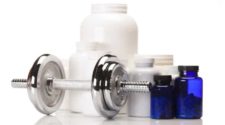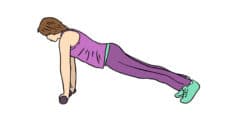When gym-goers are asked to flex their muscles, 90% of the time they bust out the old tried and tested double bicep flex.
A set of sleeve-busting guns may be desirable. However, for some bodybuilders, biceps are actually their weakest body part, both in terms of appearance and functionality. One reason for a lacking set of biceps is that the muscle may not always get evenly worked.
The bicep muscle (bicep brachii) consists of two heads—hence the name bi-cep. The muscle has a short head and a long head. The long head is also known as the outer head and the short head as the inner head. Today, we’re going to focus on outer bicep training!
Located on the outside of the upper arm, the long head of the bicep is what helps give the muscle so much size and development. If your biceps are lacking, these outer bicep workout tips should get you back on track.
1. Focus on elbow positioning
When training your arms, whether you’re working your biceps or your triceps, elbow positioning is everything. Now, when you perform exercises in which the upper arm is located behind the body, you’ll find that the outer head of the bicep gets a much better stretch than the inner head.
Because of this, it is able to generate more force so the exercise becomes more efficient. For exercises where your upper arm is positioned in front of the body, i.e. with wide-grip barbell bicep curls, the long head becomes slackened and the shorter head is recruited instead.
If you adjust your grip to a much closer grip, however, you’ll notice that your elbows are now partially behind your body. Now the outer biceps will be targeted much more effectively.
2. Keep an eye on your grip
As we’ve just touched on, the grip is important for training both bicep heads.
Using an EZ bar to perform bicep curls, for example, is not the same as using a barbell. Imagine gripping an EZ bar and take a look down at where your palms are. EZ bar curls utilize an underhand grip with both palms facing each other, which is an almost neutral position. Now, do the same thing but with a barbell and you’ll see that your palms are now facing up into the air instead.
EZ bar curls place more stress on the outer biceps and take the strain off of your wrists. A supinated grip (palms facing each other) is fantastic when it comes to the long head of the biceps!
What’s more, a narrow grip is better for outer bicep development, whereas a wide grip is better for inner bicep development.
3. Alter the position of your arms
It isn’t just your elbows and your grip that you should monitor if you want to target the outer biceps. Studies have found that altering the angle of your arm as you perform exercises will help you target the different heads of the muscle.
This is why incline seated dumbbell curls will work slightly different portions of the muscle than upright seated dumbbell curls or standing dumbbell curls. It’s also why close-grip barbell preacher curls work differently than close-grip barbell curls or drag curls.
Again, it all goes back to elbow positioning. For working the long head of the biceps, look for exercises that place your arms at an angle in which your elbows are located behind your torso.
4. Don’t forget those hammers !
To work the biceps, the vast majority of exercises you perform will be a variation of a curl.
Hammer curls activate bulks of muscle fibers located within the outer head of the biceps. Again, just look at where your arms and elbows are situated as you perform the exercise. Exercises performed with a neutral grip (palms facing each other) are great for working the outer biceps. This is why some people perform bicep curls with a triceps bar or a Swiss bar.
5. Avoid cable overhead bicep curls
In general, cable overhead bicep curls are a great addition to any seasoned gym-goer’s workout. This exercise is performed on a high-pulley cable crossover machine. It mimics the movement of performing a classic double bicep pose. However, since we’re looking to specifically target the long head of the bicep muscle, it is an exercise that should be avoided.
The reason is that the outer head helps to move your arms towards the torso (adduction). Cable overhead bicep curls are performed when your arms are lifted away from the body, though. As a result, it reduces the load onto the bicep’s outer head.
6. Train right
When working the outer head of the biceps, how you train will very much determine how hard the muscle is worked. Here are some tips to consider when planning an outer bicep workout:
- Always look for a full range of motion for a deeper stretch.
- Focus on the part of the muscle you want to grow.
- Try to include both high volume and low volume training principles into your routine.
- Aim for 8–15 reps in each set and 6–10 total sets throughout the week for bicep training.
- Use weights that really test you.
7. Effective outer bicep exercises
Now we’re going to leave you with some of our favorite tried and tested outer bicep exercises for you to try the next time you’re at the gym:
- Hammer curls
- Low cable curls, as they provide a fantastic stretch on the outer head
- EZ bar curls
- Drag curls
- Seated incline dumbbell curls
- Narrow grip barbell curls
- Preacher curls
Bicep workouts focusing on the outer head
Here are two bicep workout examples with a focus on the outer head:
Seated incline dumbbell curls—3 sets of 8-10 reps
Drag curls—3 sets of 10-12 reps
OR
Narrow grip barbell curls—3 sets of 6-12 reps
Low cable curls—4 sets of 8-12 reps

Reference
This post contains affiliate links.









Leave a Reply